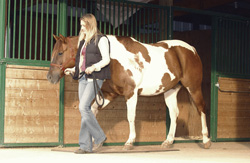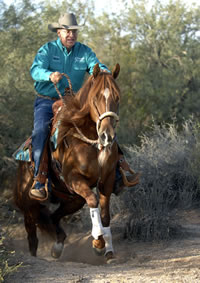It’s the middle of winter. Freezing rain, snow, and arctic temperatures are enough to put your riding (and training) on ice. While riding in the snow can be fun, if it’s slippery or conceals ice, it can be dangerous. If the footing outside isn’t safe and an indoor arena’s not available, you might think you’re doomed to just feed and muck out stalls until spring.
But you can train–despite the bad weather–by using spaces as small as an aisle, a stall, or even a dry area under the eaves of your barn. We’ll show you how to tune up your horse in three categories: conditioning, training reinforcement, and obedience. Before you begin, read “Turn Them Out First,” at the end of this article. Then try these tips and fill those gray days with fun and accomplishment–for both of you.

Conditioning
Horses are like humans when it comes to physical conditioning. As they get older, it’s harder for them to stay in shape if they exercise in spring, summer, and fall, then take winter off. For most horses 5 years old and older, year-round conditioning is beneficial for longevity and health. Here’s what you can do:

- Turn on the forehand. The horse pivots around his inside foreleg, cutting an outer concentric circle with his other legs. You can start from the ground, then do it under saddle in an aisle if you have room. Forehand turns are beneficial because they provide stretching and work the muscles and joints by moving the horse laterally.
- Turn on the hindquarters (or haunches). The horse turns around his inner hind leg, which remains on the spot or makes a small circle, while his other legs cut a larger outer concentric circle. This is done under saddle, but you can try on the ground, as well. Like the forehand turn, it provides exercise and stretching by moving the horse laterally.
- Backing.This is a good exercise to perform in a barn aisle. You can do it from the ground or under saddle. Make sure you back your horse straight, which will condition his hindquarters.
- Neck flexion from the ground. Outfit your horse in a snaffle bit with split reins. If you stand him next to a wall or stall, he can’t turn his hindquarters away when you ask him to give to bit pressure when you lift the rein. Stand next to his withers, holding the rein above it, and bring the horse’s nose around in that direction to stretch his neck. You can flex his neck to both sides. This will relax your horse and is also good for training and obedience. It will make him lighter and more responsive, improve steering, and teach or reinforce the concept of yielding to pressure. (For a detailed description, see Clinton Anderson’s “Flex Your Horse’s Neck from the Ground.”)
Training Reinforcement
Horses don’t forget their training, but they can get a little rusty if they haven’t performed a routine for a while. The following tips will reinforce skills for certain classes, but they’re good for general horsemanship, as well. These are groundwork exercises.
Speed control on a lead. The premise is to teach your horse to lead freely–and quietly–next to you at various walking speeds and the jog. This is necessary for halter and showmanship classes, but it’s also beneficial for any horse to know. With his lead rope in your hand, have your horse match your stride as you take long steps, or you can even jog. You can do this in an aisle,under a shed row roof, or on the dry side of a long barn.

- Responding to “whoa.” Every horse needs to know this basic command for training and safety. Walk your horse to a stall door or the barn entrance, and stop him by saying “whoa.” If he continues forward, back him to the stopping spot and repeat “whoa.”
- Setting up square. Required for halter and showmanship. The goal is to set up your horse squarely with his feet up underneath him so you can present him to a judge. After telling your horse “whoa,” hand-set your horse’s feet, starting with the right hind foot, then the left. Next, set the right front foot and the left with your hand. After your horse has learned to stand in the correct position, start working him from the halter so you can use it to move his feet. (For more details, see “Set-Up Smarts,” in the June 2006 Horse & Rider.)
- Backing into a “chute” made of parallel poles or cones. This maneuver is required in some timed events, such as calf roping, in which a horse must start the event from a “box.” It’s also useful in trail classes and general horsemanship. Be patient as you back your horse into the “chute” because some horses are reluctant at first to do it.
- Walking on a “bridge.” Place large pieces of plywood lengthwise in an aisle to simulate a trail-class bridge. After he masters it as groundwork, you can do it under saddle.
Obedience
An obedient horse is a safe horse, not only for himself, but his rider. The following tips can be done from the ground to reinforce good manners, patience and safety.

- Tie-up acceptance. Also called “patience training.” Regularly tie your horse in a safe place so he learns to wait patiently instead of pawing or fussing. Do it just often enough and long enough that he learns to accept it. This is almost as important as your horse knowing “whoa” because if he won’t tie quietly at home, you can’t leave him tied safely in an unfamiliar place.
- Pick up both feet from the same side. Pick up the near side hoof, but instead of walking around to the other side, pick up the offside hoof from the same side. This makes cleaning and picking out your horse’s hooves easier and faster because you don’t have to walk around him as often.
- Lower head on request. This makes it easier to put your horse’s bridle on. It’s also good for controlling a horse’s “attitude” when he doesn’t want to respond.
Turn Them Out First
A horse can’t concentrate and respond to commands when he’s full of energy. If he’s been in a stall for a while, he needs to blow off steam. For his safety–and that of his handler–turnout time is important, says Team Horse & Rider member Lynn Palm, a world-renowned competitor and trainer who has earned more than 34 world and reserve championships.
Because one of Lynn’s two training facilities is located in Bessemer, Mich. (the other’s in Ocala, Fla.), she knows what it’s like to own horses during long winters. But even in places like Michigan, she maintains, you can work your horse outdoors.
If you live in a place that has ice frequently, consider outfitting your horse with borium shoes, she notes. “And ride your horse in the snow,” she says. “They like it and you will, too.”
But don’t try to work your horse indoors without first giving them turnout time, she admonishes. “Try to turn your horses out daily if they must be kept in a stall,” she says.
“The best exercise for a horse in winter is to work them at liberty. Work in both directions from the ground at the walk, trot, and canter with no attachments for a maximum of 20 minutes. Then you can work your horse indoors. He will do it more quietly, stay fit, and continue to build muscle. His joints will be strong, and he’ll be happy.”
If you don’t have a work area with footing you can use during winter, consider creating one. Although special all-weather footings are available (search online for ‘all weather footing’), they can be expensive.
But it’s hard to beat sand. “Sand is one of the best footings,” says Lynn. “It’s less expensive. You can work on it sooner after ice has melted than on a clay-type ground.”
Lynn prefers to school her horses in an oval area, rather than a round pen, so they can be worked on straight lines as well as curves. This develops a horse’s balance and fitness better, she says. She recommends a pen that’s a minimum 60 feet wide by 100 feet long, but one that’s 70 to 80 feet by 150 feet is most desirable.
While working with an untrained horse, or one that’s sensitive, excitable, or over-responsive, consider wearing a helmet. Remember that it can more difficult to get away from a fractious horse when you’re in a small space, too.
Extras to Remember
Bobbie Skelton has worked with hundreds of horses as a riding instructor at Colorado State University, where she has taught the horse training laboratory, equine science, and equine sales management since 2002. The 1994 CSU graduate also taught equine science at colleges in Oklahoma and Texas, and has coached champion collegiate horse-judging teams.

Bobbie offers these suggestions when doing small space training. They can be applied to any equine instruction, as well
- Change the routine. Keep exercises from becoming monotonous. Some horses get bored and ill-tempered if they’re asked to do the same things in the same order repeatedly. For example, you could reinforce “whoa” one day; on another, you might turn on the forehand. This will also prevent them from anticipating your commands.
- Have a plan. Know what you want your horse to do and reward him when he does it correctly. “That’s where your average horseperson gets into trouble,” Bobbie says. “They don’t think about what they want before they ask their horse to do it, so they end up teaching him to do something they don’t want him to do without realizing it.”
- Quality counts. A horse’s responsiveness is not a result of how much you handle them. It’s the quality–not the quantity–of handling that counts.
- Consistency is key. What you ask, how you ask, and the release of pressure are the best ways to maintain responsiveness.
- Don’t overdo it. “I think working with a horse over the winter can be useful if done in moderation,” Bobbie advises. “Turning them out first is important.”
The editors wish to thank Melissa Peterson of Shingle Springs, Calif., and her Paint mare, Butterscotch, for serving as models for this article.
This article originally appeared in the January 2007 issue of Horse & Rider magazine.






